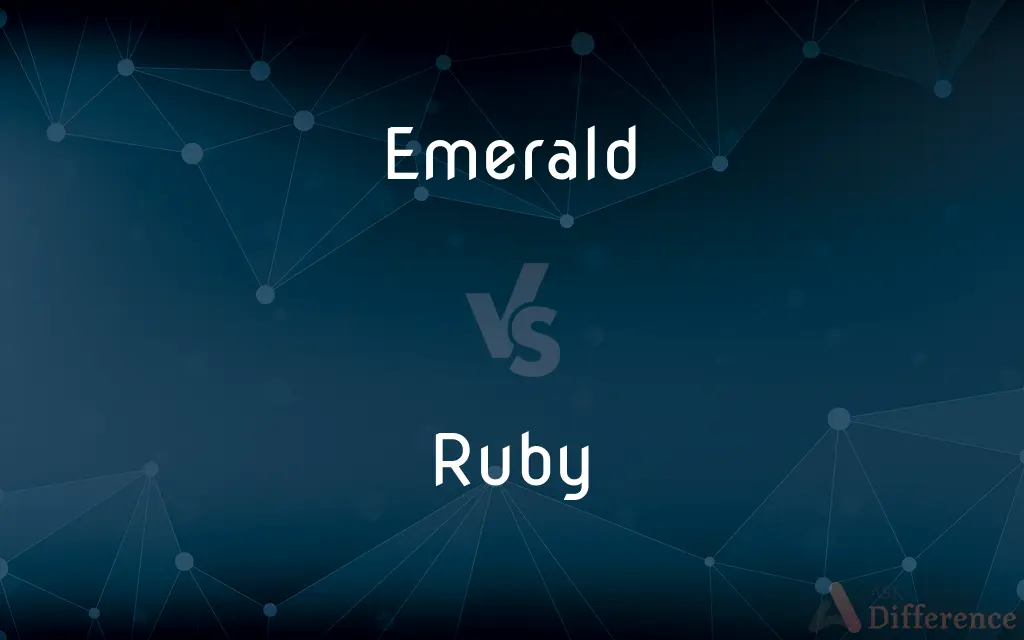Emerald vs. Ruby — What's the Difference?
By Tayyaba Rehman & Maham Liaqat — Updated on May 13, 2024
Emeralds are green gemstones known for their inclusions and lush color, while rubies are valued for their vivid red hues and excellent hardness.

Difference Between Emerald and Ruby
Table of Contents
ADVERTISEMENT
Key Differences
Emeralds, belonging to the beryl family, are prized for their rich green color, which comes from traces of chromium and sometimes vanadium. On the other hand, rubies are red gemstones from the corundum family, where their color stems from chromium as well. Both stones are highly valued in jewelry but have distinct coloration and chemical compositions.
Emeralds are known for their inclusions, often referred to as "jardin," which are acceptable and expected in natural stones. These inclusions are typically seen as adding character, whereas rubies are often appreciated for their clarity and the way they handle light. While inclusions in rubies decrease their value, they are seen as a unique fingerprint in emeralds.
The color of an emerald is its most defining feature, with the most sought-after shade being a deep, vivid green. In contrast, rubies are celebrated for their vibrant red colors, ranging from rich darkish red to pigeon blood red, a highly coveted hue. The intensity and saturation of color significantly influence the value of both gemstones.
When it comes to hardness, rubies score a 9 on the Mohs scale, making them one of the hardest gemstones after diamonds. This hardness allows for more extensive use in various types of jewelry. Emeralds, however, have a hardness of 7.5 to 8 but are often more brittle due to their inclusions, requiring more careful handling.
Both gemstones are used across various cultures to symbolize different virtues; emeralds are often associated with rebirth and love, making them popular for spring and bridal jewelry. Rubies, symbolizing passion and energy, are frequently used in pieces that signify romance and strength.
ADVERTISEMENT
Comparison Chart
Family
Beryl
Corundum
Color
Green, varying from light to deep vivid green
Red, from pinkish to deep pigeon blood red
Chemical Elements
Beryllium aluminum silicate with chromium/vanadium
Aluminum oxide with chromium
Hardness
7.5-8 on Mohs scale
9 on Mohs scale
Inclusions
Common and add character
Less desirable unless they form asterism
Compare with Definitions
Emerald
Valued in high-end jewelry, particularly in engagement and anniversary pieces.
Her emerald engagement ring was the talk of the town due to its vibrant color.
Ruby
Highly prized for its deep red color and excellent durability.
The ruby's vivid red color caught everyone's eye at the exhibition.
Emerald
Often associated with wealth and tranquility.
Ancient rulers wore emeralds to symbolize their status and calm leadership.
Ruby
A red gemstone and a variety of the mineral corundum.
The crown jewel of the collection was a flawless ruby.
Emerald
Known for its lush green color and inclusions.
He chose an emerald with visible inclusions, appreciating its natural beauty.
Ruby
Often associated with romance and energy.
The ruby necklace was a passionate anniversary gift, reflecting their fiery love.
Emerald
Emerald is a gemstone and a variety of the mineral beryl (Be3Al2(SiO3)6) colored green by trace amounts of chromium and/or sometimes vanadium. Beryl has a hardness of 7.5–8 on the Mohs scale.
Ruby
Popular in both modern and vintage jewelry settings.
Her vintage ruby earrings were a perfect match for her modern gown.
Emerald
A bright green precious stone consisting of a chromium-rich variety of beryl
An emerald necklace
Ruby
A ruby is a pink to blood-red colored gemstone, a variety of the mineral corundum (aluminium oxide). Other varieties of gem-quality corundum are called sapphires.
Emerald
A bright green colour
The sea glistened in shades of emerald and jade
Ruby
A precious stone consisting of corundum in colour varieties varying from deep crimson or purple to pale rose
A ruby eternity ring
A necklace of rubies
Emerald
A slender-bodied green moth, the colour of which tends to fade as the moth ages.
Ruby
An old type size equal to 51/2 points.
Emerald
A hawker dragonfly with a metallic green body.
Ruby
A red, translucent variety of the mineral corundum, highly valued as a precious stone.
Emerald
A small hummingbird with bright metallic green plumage and darker wings and tail, found mainly in the area of the Caribbean and Central America.
Ruby
Something, such as a watch bearing, that is made from a ruby.
Emerald
Bright green in colour
Beyond the airport lay emerald hills
Ruby
A dark or deep red to deep purplish red.
Emerald
A brilliant green to grass-green transparent variety of beryl, used as a gemstone.
Ruby
Of the color ruby.
Emerald
A strong yellowish green.
Ruby
A clear, deep, red variety of corundum, valued as a precious stone.
Emerald
Of a strong yellowish green.
Ruby
(obsolete) A red spinel.
Emerald
Any of various green gemstones, especially a green transparent form of beryl, highly valued as a precious stone.
Ruby
A deep red colour.
Emerald
Emerald green, a colour.
Ruby
(tincture) The tincture red or gules.
Emerald
Any hummingbird in the genera Chlorostilbon and Elvira; and some in the genus Amazilia
Ruby
The size of type between pearl and nonpareil, standardized as 5½-point.
Emerald
(entomology) Any of various species of dragonfly of the family Corduliidae.
Ruby
A ruby hummer, a South American hummingbird, Clytolaema rubricauda.
Emerald
A size of type between nonpareil and minion, standardized as 6½-point.
Ruby
A red bird-of-paradise, Paradisaea rubra.
Emerald
Of a rich green colour.
Ruby
A pronunciation guide written above or beside Chinese or Japanese characters.
Emerald
To ornament with, or as if with, emeralds; to make green.
Ruby
Of a deep red colour.
Emerald
A precious stone of a rich green color, a variety of beryl. See Beryl.
Ruby
To make red; to redden.
Emerald
A kind of type, in size between minion and nonpare l. It is used by English printers.
Ruby
A precious stone of a carmine red color, sometimes verging to violet, or intermediate between carmine and hyacinth red. It is a red crystallized variety of corundum.
Of rubies, sapphires, and pearles white.
Emerald
Of a rich green color, like that of the emerald.
Ruby
The color of a ruby; carmine red; a red tint.
The natural ruby of your cheeks.
Emerald
A green transparent form of beryl; highly valued as a gemstone
Ruby
That which has the color of the ruby, as red wine. Hence, a red blain or carbuncle.
Emerald
A transparent piece of emerald that has been cut and polished and is valued as a precious gem
Ruby
Any species of South American humming birds of the genus Clytolæma. The males have a ruby-colored throat or breast.
Emerald
The green color of an emerald
Ruby
Ruby-colored; red; as, ruby lips.
Emerald
A green gemstone that is a variety of the mineral beryl.
The necklace was adorned with a large emerald surrounded by diamonds.
Ruby
To make red; to redden.
Emerald
Believed to represent rebirth and love.
They exchanged emerald rings as a symbol of their everlasting love.
Ruby
A transparent piece of ruby that has been cut and polished and is valued as a precious gem
Ruby
A transparent deep red variety of corundum; used as a gemstone and in lasers
Ruby
A deep and vivid red
Ruby
Having any of numerous bright or strong colors reminiscent of the color of blood or cherries or tomatoes or rubies
Ruby
Symbolizes passion, protection, and prosperity.
Warriors in ancient times wore rubies to grant them courage in battle.
Common Curiosities
Are emeralds or rubies more valuable?
The value can vary widely but generally, high-quality rubies are rarer and can be more valuable than emeralds.
What are the typical uses of emeralds and rubies in jewelry?
Emeralds are popular in pendants and rings, while rubies are frequently used in rings, earrings, and as center stones in multi-gem pieces.
What makes emeralds and rubies different in color?
Emeralds are green due to chromium/vanadium, while rubies are red due to chromium content.
What are the historical significances of emeralds and rubies?
Emeralds have been cherished since ancient Egypt, while rubies have been revered in Asian countries for their supposed protective powers.
Do the inclusions in emeralds affect their value like they do in rubies?
In emeralds, inclusions are expected and do not significantly detract from value unless excessive; in rubies, inclusions decrease value unless they cause asterism (star effect).
How do the markets for emeralds and rubies differ globally?
The market for rubies is particularly strong in Asia, while emeralds have a broad appeal in Western and Eastern markets alike.
Can emeralds and rubies be treated to enhance their appearance?
Yes, both stones can undergo treatments; emeralds are often oiled to improve clarity, while rubies might be heat-treated to enhance their color and clarity.
How should emeralds and rubies be cared for?
Emeralds require careful handling to avoid damage from their inclusions, whereas rubies, being harder, are easier to maintain but still require protection from harsh impacts.
Which stone is more suitable for daily wear?
Rubies, due to their higher hardness, are more suited for daily wear compared to emeralds.
What are the astrological beliefs associated with emeralds and rubies?
Emeralds are thought to be beneficial for those born in May, enhancing intellect and emotion, while rubies, July's stone, are believed to boost energy and passion.
Can the color of emeralds and rubies vary?
Yes, emeralds can range from lighter to darker green, while rubies may vary from pinkish red to deep red.
What cultural significance do emeralds hold?
Emeralds are considered symbols of fertility and rebirth in many cultures.
What is the impact of synthetic emeralds and rubies on their market?
Synthetic versions are available at a lower price, providing options for those desiring the look without the cost, though they affect the market by providing alternatives to natural stones.
What kind of settings enhance the appearance of emeralds and rubies?
Emeralds are often set in gold to enhance their green color, while rubies can be set in both white and yellow gold to accentuate their vibrancy.
What is the rarest color of ruby?
The "pigeon blood" red color is the rarest and most valuable shade for rubies.
Share Your Discovery

Previous Comparison
Detect vs. Monitor
Next Comparison
Novation vs. AlterationAuthor Spotlight
Written by
Tayyaba RehmanTayyaba Rehman is a distinguished writer, currently serving as a primary contributor to askdifference.com. As a researcher in semantics and etymology, Tayyaba's passion for the complexity of languages and their distinctions has found a perfect home on the platform. Tayyaba delves into the intricacies of language, distinguishing between commonly confused words and phrases, thereby providing clarity for readers worldwide.
Co-written by
Maham Liaqat















































